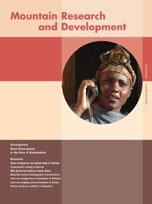The present article analyzes the land use dynamics caused by hydropower dam construction in 1973 in the Fincha'a watershed (1318 km2), a tributary of the Blue Nile. Aerial photos (1957 and 1980) and an ASTER satellite image of 2001 were used to make 3 land use maps of the watershed using a geographic information system (GIS). The 239-km2 water reservoir inundated 100 km2 of grazing land, 120 km2 of swamp, 18 km2 of cropland, and 1.2 km2 of forestland. In 2001, cropland covered 77% of the land potentially available for community use, indicating that there is hardly any free land available for expansion to accommodate new farmers. Relocated communities operate on relatively small parcels of land situated either on steep slopes or in flood-prone areas. Consequently, they exhaustively utilize the trees available on their holdings, and convert grassland and bush-land to cropland, without applying sufficient soil conservation measures. Farmers resettled at or near bodies of water and swamps, however, are affected by seasonal fluctuations of water levels that very often inundate croplands, grazing land, and homes. The demand for cropland and grazing land is increasing as reservoir and swamp areas expand and new families are created. Soil erosion in steep areas can no longer be reduced in the traditional farming system. These enforced land use changes, combined with a lack of appropriate land management practices, may increase erosion and reservoir sedimentation. This could affect food security and electric power production in the near future.
How to translate text using browser tools
1 February 2008
Hydropower-Induced Land Use Change in Fincha'a Watershed, Western Ethiopia: Analysis and Impacts
Bezuayehu Tefera,
Geert Sterk
Ethiopia
GIS
land use change
remote sensing
water reservoir





